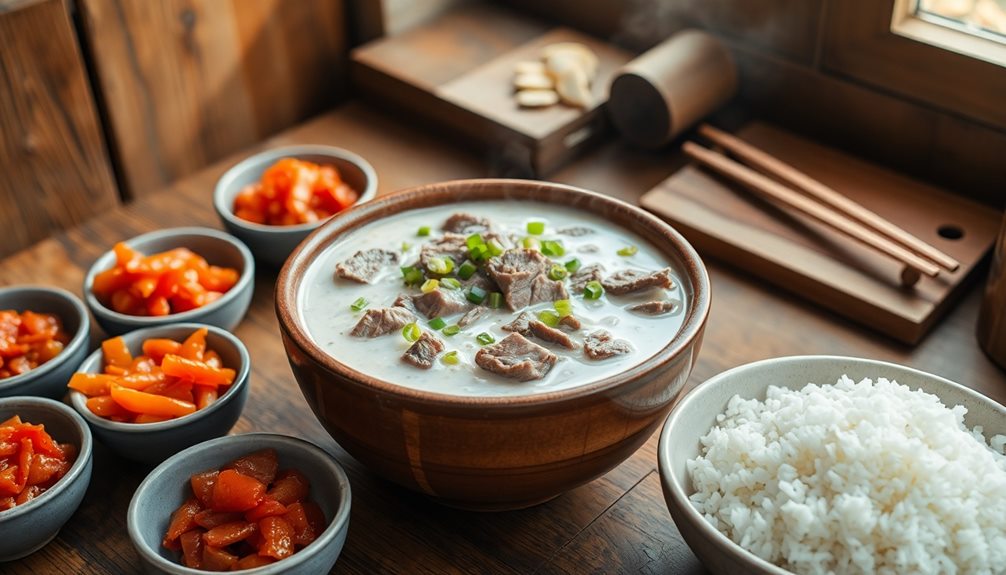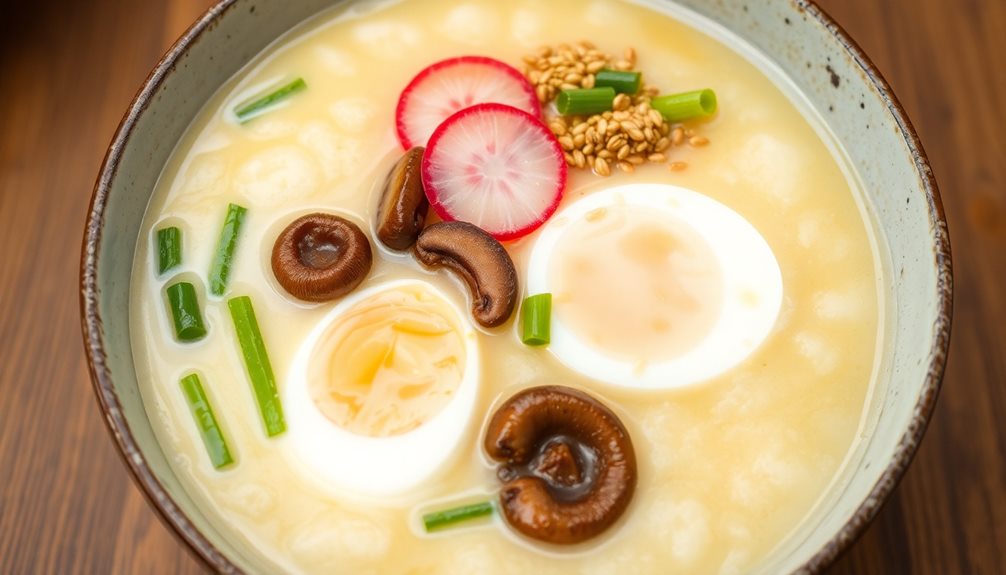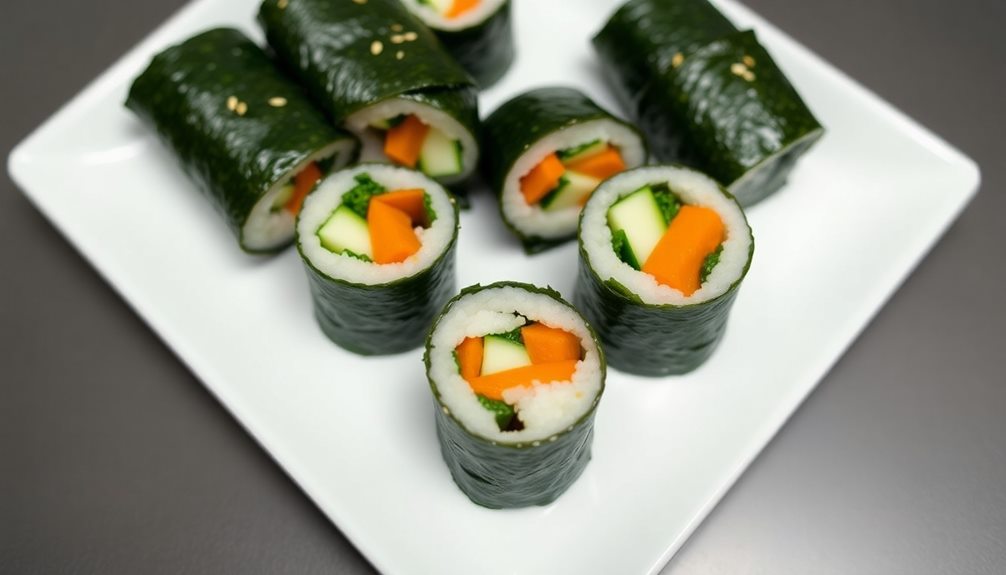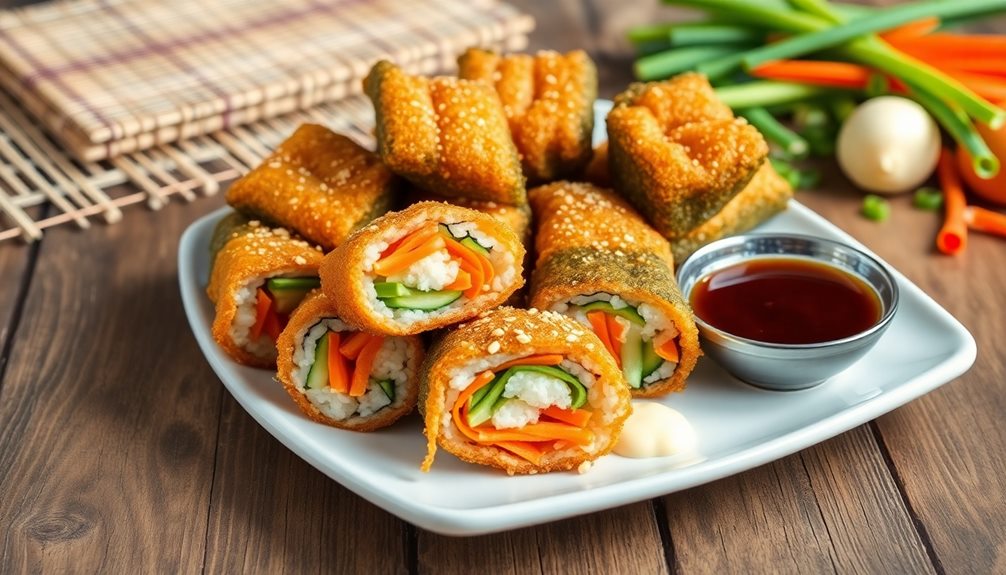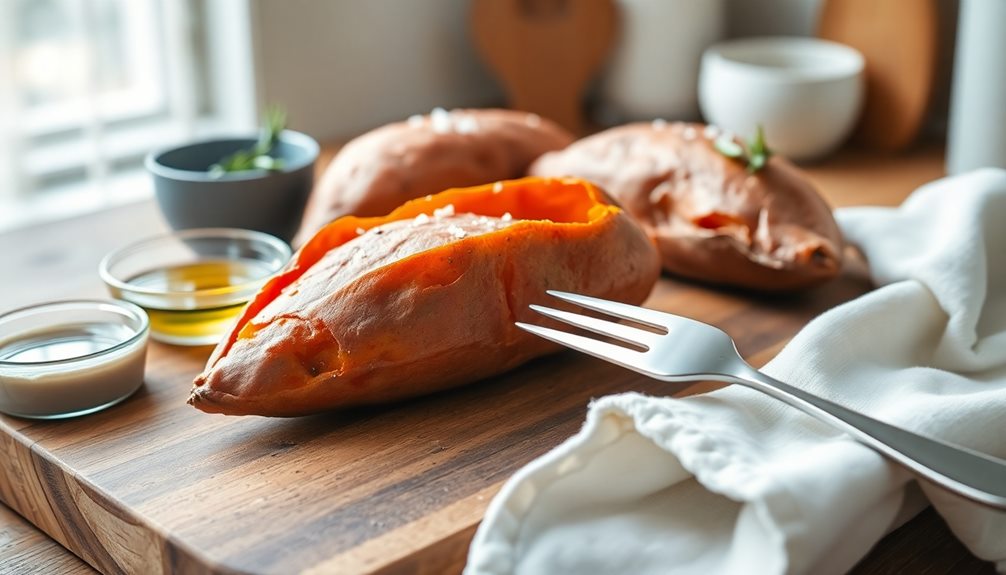Chapagetti is a tasty instant noodle dish that mixes delicious noodles with a savory black bean sauce! To make it, you start by boiling water and adding your noodles. After cooking them until they're fluffy, you stir in the seasoning packet for that yummy flavor. You can add colorful veggies and your choice of protein, like chicken or tofu, to make it even better! It's super simple and can be done in just a few minutes. You'll love how quick and fun it is to create your unique Chapagetti masterpiece, and there's even more to discover about personalizing this dish!
Key Takeaways
- Chapagetti is an instant noodle dish inspired by the traditional Korean Jajangmyeon, featuring a savory black bean sauce for rich flavor.
- Cooking involves boiling water, adding noodles, and stirring in the seasoning packet for a quick and easy meal.
- Enhance your Chapagetti by adding stir-fried vegetables and your choice of protein, such as chicken, beef, or tofu.
- The dish is customizable, allowing for personal touches with spices or additional toppings to suit individual tastes.
- Sharing Chapagetti with friends or family creates a fun and memorable cooking experience, celebrating the joy of food together.
History
The allure of Chapagetti, a beloved Korean instant noodle dish, lies in its unique blend of flavors and textures.
But have you ever wondered where it all began? Chapagetti was inspired by a traditional Korean dish called Jajangmyeon, which features noodles topped with a savory black bean sauce. This delicious combination has been a favorite in Korea for many years.
In the 1980s, the Korean food company Nongshim decided to create an instant version of this classic dish. They wanted to make it easy for everyone to enjoy the rich taste of Jajangmyeon without spending hours in the kitchen.
With some clever tweaking, they came up with Chapagetti. It quickly became popular in Korea and beyond, thanks to its convenience and delightful flavor.
Chapagetti stands out because it captures the essence of the original dish while being quick to prepare. You can enjoy it as a snack, a meal, or even as a side dish.
Its rise in popularity has made it a staple in many households, allowing you to experience a taste of Korea right at home.
Cooking Steps
When the noodles are soft, drain the water, but save a little—about half a cup—just in case you want a saucier dish.
Next, return the noodles to the pot. Sprinkle in the seasoning mix and pour in the oil. Mix everything together well until the noodles are evenly coated and look deliciously shiny.
Now, if you want to take your Chapagetti to the next level, you can add some cooked veggies or even a fried egg on top. It makes your meal even yummier!
Serve it up in a bowl, and don't forget to take a moment to admire your creation. Enjoy your tasty Chapagetti and share it with friends or family. They'll be impressed with your cooking skills!
Step 1. Boil Water in a Pot

To kick off your Chapagetti preparation, fill a pot with at least four cups of water and place it on the stove over high heat. It's important to use enough water so that your noodles can cook evenly.
As the water heats up, you can watch it closely. You might see bubbles starting to rise, and that's a good sign!
While you wait, you can gather your other ingredients and get excited about the delicious meal that's coming. Boiling water is a key step in making your Chapagetti, so don't rush it. It usually takes a few minutes, depending on your stove.
You'll know the water is ready when it's bubbling vigorously.
Once you see that rolling boil, you're almost ready to cook the noodles. Just remember, boiling water can be very hot and splashing can happen, so be careful.
Keep an eye on the pot and don't leave it unattended. This is the start of something tasty, and you're doing great!
Soon, you'll be ready for the next step in your Chapagetti adventure. Enjoy the process and get ready for a delicious meal!
Step 2. Add Noodles to Boiling Water
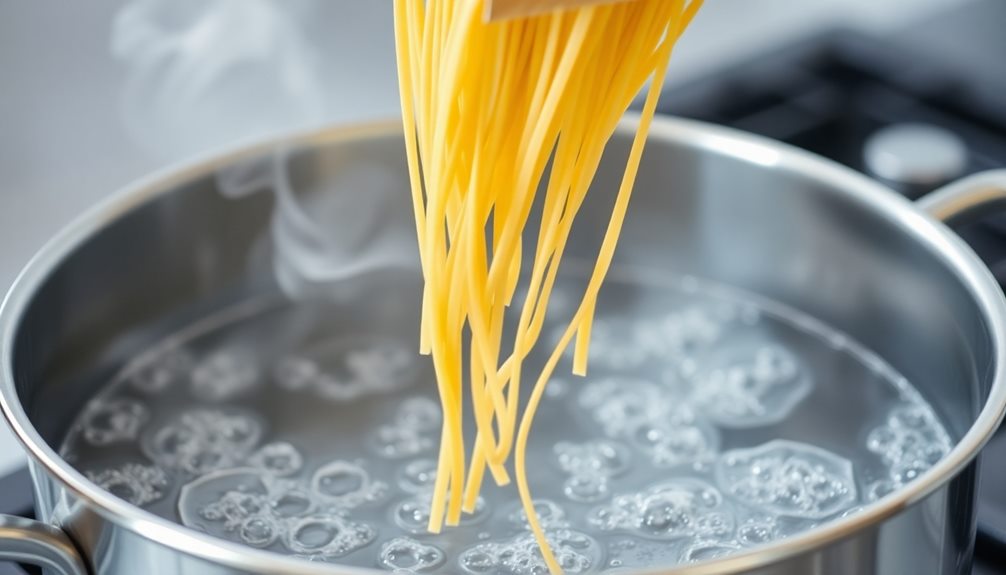
As the water reaches a rolling boil, carefully add the noodles to the pot. Make sure to use a fork or chopsticks to gently separate them if they stick together. You'll hear a satisfying sizzle as the noodles hit the water, and that's a good sign!
Watch them closely, because they'll start softening up pretty quickly. It's important to remember that maintaining good oral hygiene, especially after enjoying meals, is essential for overall health, including reducing the risk of dental issues that could arise from sticky noodle remnants.
Let the noodles cook for about 4 to 5 minutes. During this time, you can stir them occasionally to keep them from clumping. It's like giving them a little dance in the pot!
As they cook, you'll notice them becoming more tender and fluffy. This is when the magic begins!
While you're waiting, you can get excited about the delicious fusion flavors that are coming soon. The smell of boiling noodles is just a hint of all the tasty goodness to come.
When the time's up, use a slotted spoon or a strainer to carefully lift the noodles out of the pot. Make sure to let any excess water drip off.
Now you're all set to move on to the next step, where you'll bring in those incredible seasonings! Enjoy this fun cooking moment!
Step 3. Stir in Seasoning Packet
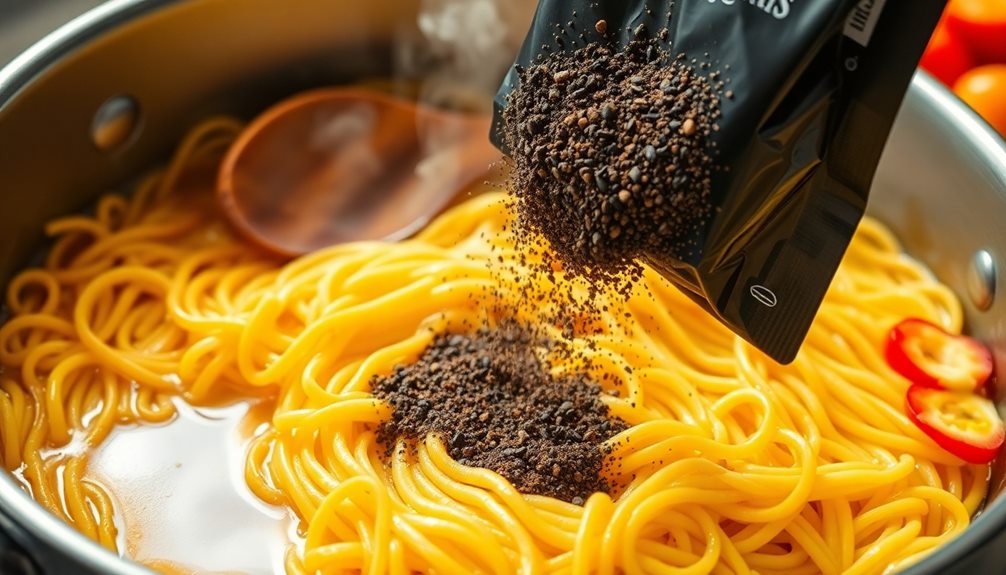
With the noodles perfectly cooked and ready, it's time to elevate the dish by stirring in the seasoning packet. Grab that little envelope, and let's sprinkle in all that delicious goodness! As you mix in the seasoning, watch as it effortlessly dissolves into the warm noodles, filling the air with a tantalizing aroma. For an extra layer of texture and flavor, why not pair the dish with something crunchy like a fried seaweed rolls recipe? The crispy exterior of the seaweed rolls will perfectly complement the savory noodles, creating a satisfying combo of taste and texture.
Carefully open the packet, being careful not to spill any of the tasty seasoning inside. Did you know that coffee can also enhance your mood during cooking? Coffee's health benefits might just make this culinary experience even more enjoyable!
Now, pour the seasoning over your noodles. As you do this, you'll start to notice the wonderful aroma wafting up, making your mouth water.
Using a fork or chopsticks, gently toss the noodles. You want to make sure every noodle gets coated in that rich, savory flavor.
Keep stirring until all the seasoning blends in nicely, turning your noodles into a gorgeous mix of colors and flavors. Don't rush—take your time! A good stir ensures that every bite will be just as tasty as the last.
As you mix, you might even see some steam rising from the pot, which is always a good sign. This is the moment when your Chapagetti starts to transform into something truly special.
Get ready, because the best part of this cooking adventure is just around the corner!
Step 4. Add Vegetables to Noodles
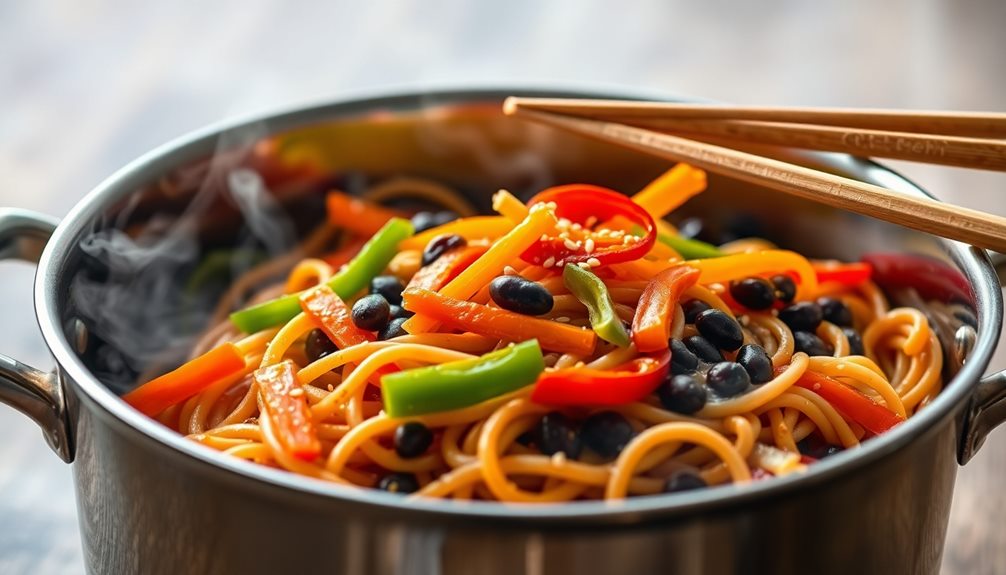
Now that your noodles are perfectly seasoned, it's time to toss in some vibrant vegetables for added flavor and nutrition. Adding veggies not only makes your dish colorful but also boosts its healthiness. You can choose from a variety of options like carrots, bell peppers, or even spinach—whatever you love!
Start by chopping your vegetables into bite-sized pieces. This way, they'll cook evenly and mix well with your noodles.
Heat up a little oil in a pan over medium heat. Once it's hot, throw in your veggies and stir-fry them for about three to five minutes. You want them to be tender but still crisp—nobody likes mushy veggies!
After your veggies are ready, carefully add your seasoned noodles to the pan. Give everything a good mix, making sure those delicious flavors blend together. If you want to kick it up a notch, you can even sprinkle in a pinch of salt or some chili flakes for extra zing.
Once everything's well combined, it's time to serve! You'll be amazed at how much more delicious your Chapagetti becomes with these fresh, colorful veggies. Enjoy your tasty creation!
Step 5. Add Protein of Choice

After adding those vibrant vegetables, it's time to boost your Chapagetti with some protein. You can choose from a variety of delicious options! If you're a fan of meat, consider adding sliced chicken, beef, or pork. Just cook your protein in a skillet until it's nice and golden brown, then toss it in with your noodles and veggies.
Additionally, similar to how early socialization is important for puppies, ensuring a well-rounded meal with protein can enhance your overall nutrition.
Not into meat? No worries! Tofu is a fantastic choice. You can cut it into cubes, give it a quick sauté, and mix it in for a tasty, healthy twist. If you want something even quicker, try canned tuna or shrimp. Just drain the can or thaw the shrimp, and they're ready to go!
Remember to season your protein while cooking. A sprinkle of salt, pepper, or even some soy sauce can really enhance the flavor. Once you've added your protein, give everything a good stir to combine those yummy flavors.
Let it cook for a few more minutes, so everything warms up nicely.
And there you have it—a protein-packed Chapagetti that's sure to satisfy your hunger and delight your taste buds! Enjoy your delicious creation!
Final Thoughts
Creating Chapagetti at home can be a delightful culinary adventure. With its unique blend of flavors and textures, this dish is sure to become a favorite in your kitchen. You can mix it up by adding your favorite proteins, veggies, or even a splash of spice to make it your own.
The best part is, it's super easy and quick to whip up, making it perfect for busy days or when you simply want a comforting meal.
As you gather your ingredients and start cooking, let your imagination run wild! You can experiment with different toppings, sauces, and sides. Maybe you'll discover a new combination that you absolutely love.
Don't be afraid to invite friends or family to join you in this fun cooking experience. Sharing a delicious meal makes it even more special.
In the end, Chapagetti isn't just a dish; it's a chance to create memories in the kitchen. So, grab your noodles and start this tasty journey.
You'll be amazed at how something so simple can bring so much joy. Happy cooking, and enjoy every bite of your Chapagetti masterpiece!
Frequently Asked Questions
What Is Chapagetti Made Of?
Chapagetti's made of chewy noodles, a savory black bean sauce, and various seasonings. You'll often find dehydrated vegetables included, enhancing the flavor and texture, making it a deliciously satisfying meal for any occasion.
Can I Make Chapagetti Vegan?
Yes, you can make chapagetti vegan! Just swap out any non-vegan ingredients, like meat or eggs, and use vegetable broth instead of chicken broth. Enjoy your delicious, plant-based twist on this popular noodle dish!
How Long Does Chapagetti Last in the Pantry?
Chapagetti typically lasts about 6 to 12 months in your pantry when stored properly. Just make sure it's in a cool, dry place, and check for any signs of damage before using it.
Where Can I Buy Chapagetti?
You can buy Chapagetti at most grocery stores, Asian markets, or online retailers like Amazon. Check the international or noodle aisle for the best selection. It's usually easy to find, so happy shopping!
Are There Any Nutritional Facts for Chapagetti?
You'll find that Chapagetti typically contains around 350 calories per serving, with about 10 grams of protein and 15 grams of fat. Check the packaging for specific nutritional facts, as they may vary slightly.

